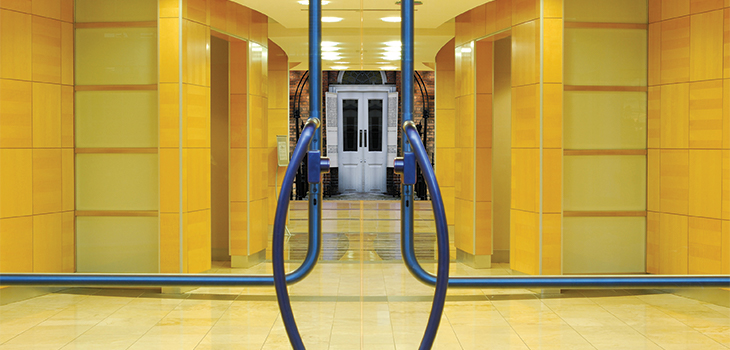*/

A chambers... in a law firm? The in-house advocacy model re-imagined: Sahar Farooqi and Jonathan Robinshaw explain how it works and where it sits under ‘the Bar’ umbrella
Since the Inns of Court came into being around the 14th century, barristers’ training, chambers’ format and make-up of the profession as a whole have undergone radical change. The majority of that modernisation has occurred, one could argue, over the last century in which we have seen a diversification of how and where training is provided as well as evolution of the Bar’s regulation. We have also seen a relaxation of the hard borders between the two nation states of the legal profession and the advent of the employed barrister. Barristers can be, and frequently are: general counsel, law firm partners and government employees. The notion of the ‘in-house’ barrister is not, then, a new one. Nor is the idea that they can be deployed by an organisation as part of a unit or team to deliver the same expertise that might otherwise require the instruction of ‘external counsel’. The CPS, for instance, would have something to say about a contrary suggestion. However, in private practice over the last decade, this model has been boldly, yet quietly, re-imagined.
Law firms of all sizes who undertake contentious work are likely to engage the services of counsel at some point. Whether that is advisory or advocacy in nature, at some stage – unless they do it themselves – the moment comes. For clients of these firms, it has always been understood and accepted that when that moment comes, instructions to counsel must follow. Innovation, though, is a hungry and watchful beast. For clients who come from jurisdictions with a fused profession, two bills can feel both alien and unwelcome. For firms inside this jurisdiction, outside of highly specialised and niche areas, it can feel like they are missing a trick in an increasingly streamlined, complete service legal market.
Why not offer their clients the services of experienced, able and comparable counsel and charge a fee for it? With enough barristers in employment, whose expertise adequately cover the work, you are streamlining the service to the client and adding certainty of fees, representation, and reporting styles and timelines. Suddenly counsel and fee earner are working in the same (virtual) place, from the same systems and aligned to the same culture and values. They are able to bounce ideas and tactics off one another ad-hoc and ensure that the client’s market strategies are pursued from inception to completion of the litigation. The client’s ‘team’ of lawyers are closer, more nimble and better connected. Clients have access to a ‘cradle to grave’ service, under one banner, with an opportunity to capture data and trends about how their matters play out through the life of a litigated matter.
Like a chambers. A national, multi-disciplinary set. The real and fundamental difference is that the ‘members’ are employed. There is a clerking team who manage and control the diaries of the barristers and advocates (more on advocates below), a practice manager who is focused on engaging with clients within and outside the firm to enhance the complexity of work undertaken by the members. Then there are the barristers, pupils and advocates themselves who are instructed by solicitors to provide advice, draft pleadings, undertake conferences, hearings, trials and appeals. All the hallmarks that you associate with chambers, because – and there is no art to this – it is a collection of counsel.
In addition, the machinery of a large law firm provides infrastructure, hardware, access to legal resources and texts, learning and development resources, HR and business development functions as well as an army of people with a direct line to clients. For counsel, the prospect of sitting among your solicitor clients is something of a dream; adding value and being first in their mind, every time. The benefits of employment are also not lost on barristers coming from self-employment.
Advocates are a USP of this type of model; individuals who have completed their legal and Bar studies but await pupillage. Under the tutelage of counsel, they are afforded advisory and advocacy opportunities across the county courts in appropriate matters which their rights of audience permit. This dovetails with the agency model, sometimes known as ‘outdoor clerking’ which is a popular service utilised by some clients. Advocates often go on to pupillage. To date, we have not counted leading counsel amongst our ranks, but the future beckons and it is not something we would ever discount.
Regulation continues to be important and the model frequently involves the business being regulated by the Solicitors Regulatory Authority and the individual being regulated by the Bar Standards Board. This is no more onerous but, in itself, reflects the symbiotic nature of the proposition.
Toying with the advocacy ball is something that law firms have done in the past. This has had a habit of fizzling out or not growing by more than a few members. First, because there is a cap placed internally, either intentionally or culturally, on the types of instructions those people are allowed to have and second, because it lacks a critical mass. A chambers consisting of three or four people probably couldn’t sustain itself if one or two people left; the same is true here. Law firms who want to do it properly have to invest in talent, infrastructure and the vision. By installing a number of people who are integrated and motivated, you can survive some departures; a pupillage scheme will also help secure organic growth. As law firms come to analyse their annual spend with counsel, using the management information available to them, the investment required increasingly makes sense. This is work they already have; they just need the talent and appropriate model to service it. If the appetite exists, our model will be emulated. We have anecdotal experience that large firms across the top 30 are increasingly interested, but until now have resisted the temptation.
Proponents of the traditional model frequently point to a perceived lack of independence for counsel. In our experience this is rarely an issue. By their nature, training and ethics, these are individuals who understand their function and responsibilities as counsel. Advice that criticises the fee earner’s approach might arguably be harder to give when they are a colleague but the reality is that, although we work in proximity, it is not through one set of eyes. Counsel, regardless of where they sit, will look through the lens of their critical and objective eye.
The provision and delivery of legal services was largely unchanged in this jurisdiction for hundreds of years – no more. While this model doesn’t actually seek to fuse the profession, it does enhance the collaborative spirit through proximity. In a world where discerning clients pay a premium for convenience, is it really a surprise that international firms are increasingly interested in offering it to them?

Since the Inns of Court came into being around the 14th century, barristers’ training, chambers’ format and make-up of the profession as a whole have undergone radical change. The majority of that modernisation has occurred, one could argue, over the last century in which we have seen a diversification of how and where training is provided as well as evolution of the Bar’s regulation. We have also seen a relaxation of the hard borders between the two nation states of the legal profession and the advent of the employed barrister. Barristers can be, and frequently are: general counsel, law firm partners and government employees. The notion of the ‘in-house’ barrister is not, then, a new one. Nor is the idea that they can be deployed by an organisation as part of a unit or team to deliver the same expertise that might otherwise require the instruction of ‘external counsel’. The CPS, for instance, would have something to say about a contrary suggestion. However, in private practice over the last decade, this model has been boldly, yet quietly, re-imagined.
Law firms of all sizes who undertake contentious work are likely to engage the services of counsel at some point. Whether that is advisory or advocacy in nature, at some stage – unless they do it themselves – the moment comes. For clients of these firms, it has always been understood and accepted that when that moment comes, instructions to counsel must follow. Innovation, though, is a hungry and watchful beast. For clients who come from jurisdictions with a fused profession, two bills can feel both alien and unwelcome. For firms inside this jurisdiction, outside of highly specialised and niche areas, it can feel like they are missing a trick in an increasingly streamlined, complete service legal market.
Why not offer their clients the services of experienced, able and comparable counsel and charge a fee for it? With enough barristers in employment, whose expertise adequately cover the work, you are streamlining the service to the client and adding certainty of fees, representation, and reporting styles and timelines. Suddenly counsel and fee earner are working in the same (virtual) place, from the same systems and aligned to the same culture and values. They are able to bounce ideas and tactics off one another ad-hoc and ensure that the client’s market strategies are pursued from inception to completion of the litigation. The client’s ‘team’ of lawyers are closer, more nimble and better connected. Clients have access to a ‘cradle to grave’ service, under one banner, with an opportunity to capture data and trends about how their matters play out through the life of a litigated matter.
Like a chambers. A national, multi-disciplinary set. The real and fundamental difference is that the ‘members’ are employed. There is a clerking team who manage and control the diaries of the barristers and advocates (more on advocates below), a practice manager who is focused on engaging with clients within and outside the firm to enhance the complexity of work undertaken by the members. Then there are the barristers, pupils and advocates themselves who are instructed by solicitors to provide advice, draft pleadings, undertake conferences, hearings, trials and appeals. All the hallmarks that you associate with chambers, because – and there is no art to this – it is a collection of counsel.
In addition, the machinery of a large law firm provides infrastructure, hardware, access to legal resources and texts, learning and development resources, HR and business development functions as well as an army of people with a direct line to clients. For counsel, the prospect of sitting among your solicitor clients is something of a dream; adding value and being first in their mind, every time. The benefits of employment are also not lost on barristers coming from self-employment.
Advocates are a USP of this type of model; individuals who have completed their legal and Bar studies but await pupillage. Under the tutelage of counsel, they are afforded advisory and advocacy opportunities across the county courts in appropriate matters which their rights of audience permit. This dovetails with the agency model, sometimes known as ‘outdoor clerking’ which is a popular service utilised by some clients. Advocates often go on to pupillage. To date, we have not counted leading counsel amongst our ranks, but the future beckons and it is not something we would ever discount.
Regulation continues to be important and the model frequently involves the business being regulated by the Solicitors Regulatory Authority and the individual being regulated by the Bar Standards Board. This is no more onerous but, in itself, reflects the symbiotic nature of the proposition.
Toying with the advocacy ball is something that law firms have done in the past. This has had a habit of fizzling out or not growing by more than a few members. First, because there is a cap placed internally, either intentionally or culturally, on the types of instructions those people are allowed to have and second, because it lacks a critical mass. A chambers consisting of three or four people probably couldn’t sustain itself if one or two people left; the same is true here. Law firms who want to do it properly have to invest in talent, infrastructure and the vision. By installing a number of people who are integrated and motivated, you can survive some departures; a pupillage scheme will also help secure organic growth. As law firms come to analyse their annual spend with counsel, using the management information available to them, the investment required increasingly makes sense. This is work they already have; they just need the talent and appropriate model to service it. If the appetite exists, our model will be emulated. We have anecdotal experience that large firms across the top 30 are increasingly interested, but until now have resisted the temptation.
Proponents of the traditional model frequently point to a perceived lack of independence for counsel. In our experience this is rarely an issue. By their nature, training and ethics, these are individuals who understand their function and responsibilities as counsel. Advice that criticises the fee earner’s approach might arguably be harder to give when they are a colleague but the reality is that, although we work in proximity, it is not through one set of eyes. Counsel, regardless of where they sit, will look through the lens of their critical and objective eye.
The provision and delivery of legal services was largely unchanged in this jurisdiction for hundreds of years – no more. While this model doesn’t actually seek to fuse the profession, it does enhance the collaborative spirit through proximity. In a world where discerning clients pay a premium for convenience, is it really a surprise that international firms are increasingly interested in offering it to them?
A chambers... in a law firm? The in-house advocacy model re-imagined: Sahar Farooqi and Jonathan Robinshaw explain how it works and where it sits under ‘the Bar’ umbrella

What’s it really like to work in the National Crime Agency’s in-house legal team? TM, a lawyer in the NCA’s Financial Disruptions Litigation team, shares a day in her life

By the Chartered Governance Institute UK Ireland

Q and A with Major Susie Brooke, Legal Officer in Army Legal Services

Have you considered being a barrister in the British Army? Here’s an insight into a career in Army Legal Services

Clare describes her journey from Crown Prosecution Service legal trainee to Senior Crown Prosecutor, a typical ‘day in the life’ and the inspiration she draws from her career

What's it like being a legal trainee at the Crown Prosecution Service? Amy describes what drew her to the role, the skills required and a typical day in the life